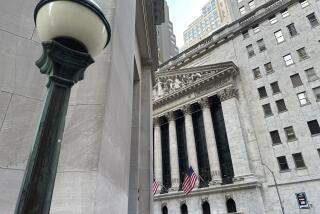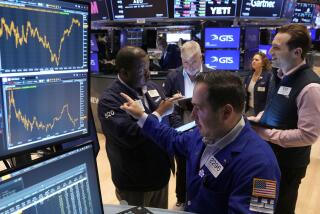Investors Could Feel Whiplash From Inevitable Rate Rebound
For much of the late 1990s, the big question about technology stocks was, “How high can they go?”
As it turned out, they went higher than most people expected--and higher than they should have gone, rational investors now would probably agree.
Today, a similar question is asked about interest rates, but in reverse--”How low can they go?” And the answer keeps coming back: lower than most people expected.
For now, the plunge in rates is considered essential to fixing the economy. But any market that takes things too far risks a painful adjustment down the road. Millions of technology investors can bear witness to that.
Last week saw one of the most dramatic one-day rate moves in the history of the U.S. bond market. The catalyst was the Treasury’s surprise announcement Wednesday that it will no longer borrow via 30-year bonds.
The news sent investors scrambling to buy existing 30-year T-bonds and other longer-term issues, fearing an eventual scarcity of such securities.
The yield on the most recently issued 30-year T-bond plummeted from 5.21% Tuesday to 4.87% by the end of trading Wednesday.
By Friday, the yield had backed up somewhat, reflecting moves by some traders to cash out. The 30-year T-bond ended the week at 4.95%.
What is most notable is simply that, except for a few days in 1998 (in the panicked aftermath of Russia’s debt crisis), investors have never before been willing to accept a yield of less than 5% on a 30-year Treasury bond, measuring back to the first such bond sales in 1977.
But this year has been all about breaking through barriers in the Treasury market. Indeed, the government’s announcement Wednesday had a major effect on yields in large part because a bullish trend in bonds--meaning, falling interest rates--already was well-established. The news was the equivalent of a squirt of lighter fluid on a very hot fire.
Even with yields on shorter-term Treasury securities, such as two-year notes and six-month bills, at the lowest levels in more than 40 years, there still are many analysts who believe we haven’t hit bottom.
When Federal Reserve policymakers gather Tuesday, they are expected to announce the 10th cut this year in their benchmark short-term interest rate, now at 2.5%. That rate is a key determinant of Treasury yields, which in turn help determine rates on other bonds, bank CDs, etc.
The Fed had been expected to cut its rate to 2.25%. Given the surge in U.S. unemployment in October, reported Friday, many on Wall Street are betting on a deeper cut: Fifteen of 24 major bond dealers polled Friday by Reuters predicted a half-point cut, to 2%, which would be the lowest for the Fed rate since the late-1950s.
Just as the technology stock surge of the late-1990s was viewed as a symbol of how healthy the U.S. economy was at the time--the “new economy,” and all that--the plunge in interest rates this year rightly is seen as an indication of how sickly the economy has become.
Low interest rates often are associated with prosperity in a time of low inflation, and that was certainly true in the 1950s.
Today, lack of concern about inflation is a factor in rates’ decline. But the bigger reason rates are at generational lows on Treasury securities is because people are afraid--including the people who sit on the Fed board.
Well before the Sept. 11 terrorist attacks, worries were building that the Fed’s aggressive rate cutting, which started in January, wasn’t spurring an economic rebound. The Fed, and even some of its critics, noted that rate cuts take time to filter into the economy. Patience was counseled.
But analysts also have pointed out the structural differences between this economic slump and others. Most recessions in the post-World War II era were triggered because demand for goods and services began to outpace supply. That boosted prices (inflation) and drove up interest rates, which in turn depressed demand.
This time, the economy’s problem has been excess investment: Too much production capacity was created in technology and other sectors by the incredible availability of capital in the late-1990s.
Meanwhile, demand has waned in part because consumers and businesses have enough stuff, and in part because high debt levels taken on in the boom years have left many people and companies anxious to bolster their finances by slowing consumption and building up cash reserves.
Clearly, some people wanted new cars badly enough to take advantage of 0% financing offers: Automakers reported last week that sales soared in October. But the auto companies’ fear is that those sales stole from demand that would have materialized in 2002.
The upshot is that lower interest rates aren’t likely to entice many companies to borrow and expand, with the U.S. factory capacity utilization rate at 75.5%, lowest since 1983.
Nonetheless, the government can continue to try to push that button, and that’s where the Treasury came in last week.
The official reasoning behind the decision to eliminate the 30-year T-bond was that Uncle Sam wants to save taxpayers some money. By shifting future borrowing (which mostly amounts to rolling over maturing debt) more toward shorter-term bonds, the government said it can take advantage of interest rates that are much lower on shorter debt securities than on longer-term ones.
By reducing the supply of longer-term issues, however, the Treasury had to know full well that it could spur a stampede by investors to buy bonds, driving down yields. And as T-bond yields fall they typically pull down other long-term rates, such as on mortgages and corporate bonds. That’s potential stimulus for the economy.
Yet the government is taking a big risk. Treasury borrowing already is heavily front-loaded: Of the $2.26 trillion in Treasury debt held by private investors, nearly two-thirds matures in five years or less.
If short-term interest rates whiplash in 2002, Uncle Sam may regret having opted to borrow more via short-term securities rather than locking in a cost of around 5% on 30-year bonds.
But short-term rates are controlled by the Federal Reserve. If the Fed chooses to keep those rates low for an extended period--as it did in 1992 and 1993 as the economy struggled to rebound from the 1990-’91 recession--the Treasury’s decision to shift its borrowing to shorter maturities could work out fine.
That was a key message many Wall Street pros took away last week from the Treasury’s decision on the 30-year bond. “I don’t think the Fed is going to quickly take away the punchbowl [of cheaper credit] this time around,” said David Schroeder, a senior bond portfolio manager at American Century Funds in Mountain View, Calif., echoing comments of many other bond pros.
At some point, however, rates are sure to rebound, assuming economic recovery is inevitable. And the deeper the decline, the nastier the rate whiplash is likely to be--whether in 2002, 2003 or beyond.
Before agreeing to lock up too much of their money at ever-lower yields today, investors should ask whether they’re letting their fears get the better of them--just as tech stock investors let greed get the best of them in 1999 and 2000.
A 3.62% annualized yield may look OK on a five-year Treasury note today, but what will it look like in two years, if the economy is revving again and interest rates are resurging?
*
Tom Petruno can be reached at [email protected]. For recent columns on the Web, go to www.latimes.com/petruno.
More to Read
Inside the business of entertainment
The Wide Shot brings you news, analysis and insights on everything from streaming wars to production — and what it all means for the future.
You may occasionally receive promotional content from the Los Angeles Times.










